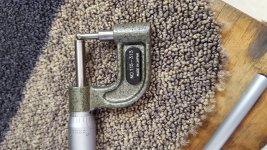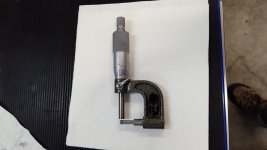OK, so would someone please explain to me how and where a ball mic saves time or adds accuracy?
I lied some when I said "I used mine once"...... I used it once, for a few days.
I actually measured quite a few things in the week I used it.
Here's what I did.
I laid out some neck-turning equipment.
I laid out some cases.
I laid out some bullets.
I laid out some notepaper pads.
I mic'd a bunch of the bullets, 2-3 places, set them in rows..... hmmm. I wrote down the numbers.
I turned some necks, I used the new ball mic and I mic'd the necks with the ball mic and wrote down the numbers.
I added up all the numbers, sevaral times cuz I'm a construction guy, and found that hmmmm.... it looks like I'll have to adjust again.
And again.
"OK, the numbers all add up"......"loaded round should measure around .2595"......
I trimmed.
I chamfered with the long taper tool and deburred and etc and etc.....
I picked a neck bushing based on this SWAG and sized a neck and seated a bullet.....
And then I mic'd the neck with the bullet in it... in about 3 places..... hmmmmm, my numbers are reasonably close but,
"WHY didn't I just do this in the first place?"
Some of my turning mandrels are large enough that I can insert/remove a bullet by hand.
Some I have to pull.
Some I have to pop out with a hammer tool.
BUT IN ALL CASES, I find that to be safe, I'll end up measuring over the loaded rounds.
And in all cases, if I just seat a bullet, measure it and subtract how much I want for clearance.... and spin out some cases......and measure a few dummy rds....which I'm going to do anyway! I never trust my own math. Not when my eyes depend on it.
bullets vary
pressure rings vary
bullet compression varies
chamfers vary
bushes vary
different bushings yield different results
etc etc
I mean, all I play with is final clearances..... why do I even CARE how thick the necks are?
Again I ask..... "why?"
Fuh'GEDDAbout "is this a good one or not?"....... "WHY?"
IMO folks come on this board for information.... information which hopefully aids them in making good choices re spending their budget......and it's hoovis of me to pass on information on items I spent my budget on. Would someone please explain to me how owning a ball mic is worth money as an aid to a beginning shooter?



